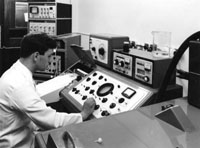
Using magnetic resonance for embryology research

Cheryll Tickle, who will deliver the final Saturday evening lecture of this year, has been using the
University's Nuclear Magnetic Resonance (NMR) facility to observe changes, in situ, in embryos.
NMR first came to the University in the early 1960s, when Roy Foster, a young lecturer in Physical Organic
Chemistry, persuaded the University to fund a nuclear magnetic resonance spectrometer for what was then the
Chemistry Department of Queens College. Today, NMR technology continues to be used by staff across many
faculties of the University.
NMR has been key to a wide range of research projects at the University; an examination of frosting in fruit,
the identification of 'secret' watermarks in banknotes, the curing of polymers, the analysis of the contents
of pigsties and the soil from beneath a buried pig, to name but a few. One interesting line of research was
in examining archeological wood from shipwrecks, as an aid to preservation.
Among the most recent projects are observations of the breakdown of pollen in soil, investigating postmortem
changes in teeth, measuring the effects of osteoporosis on bone density, attempting to measure the strength
of binding between spilt oil and marine sediments as an aid to remediation procedures, and devising standards
in testing of new dental materials. Another first is the observation of the migration of protons, hydrogen
nuclei, in ionic polymers, materials that bend when an electronic charge is applied. This has great potential
in the development of actuator devices and robotic joints.
Cheryll Tickle's lecture will take place on 22 May at 6pm in the Tower Extension lecture theatre.
Next Page
Return to May 2004 Contact

